Methods to Repair Your Swollen Laminate Without Replacing
Long ago, I have wondered how to repair swollen laminate flooring without replacing just like you do now. It was a beautiful morning as usual; I woke up and got out of bed, about to start my morning routine. However, as I put my right foot on the floor, something seemed off.
I looked down, and what I saw had completely ruined the day: my beautiful laminate flooring had buckled up! Fortunately, I have found the solution to this problem, and I will be showing you what I did today. No need to thank me!

Laminate Flooring 101: A Coveted Choice
Laminate flooring is a worthy investment, and if you are standing on it right now, you know it is true. It enhances your house curb appeal with a lovely finish, but the best part is its cheap installation and maintenance cost.
However, the biggest thing laminate flooring offers you is its resistance to scratches – thanks to a protective layer made of urethane that also gives you the shine of your dreams. You will find this feature useful, especially if you have pets with sharp claws.
To a certain extent, laminate flooring can also withstand water damage, say, when you have accidentally dropped your coffee mug. Nonetheless, if you failed to clean up the spill quickly, the fluid would seep through the surface, causing your flooring to become swollen.
Common Causes That Make Your Laminate Flooring Swell Up
Of course, it is not just coffee that is to blame for this problem. When being cleaned wrongly or affected by wastewater, your laminate flooring should also swell up easily.
Sometimes, it’s the contractor or the laminate’s quality fault, and this section will provide you with more details on how such unfortunate things occur.

1. Excessive Moisture
Besides facilitating mold growth under laminate flooring, high moisture content can result in material deformation, at times irreparable.
Water Damage
When water damage is too severe, such as caused by a leaky pipe, a bathtub overflow, or floodwaters, the excess fluid will seep through the protective layer, then the print layer, and finally the core.
Improper Cleaning
High moisture or humidity is also sourced from improper cleaning methods, for example, if you mop your flooring daily or with a dripping mop head. As recommended by experts, wet mopping should be carried out only once per week, with deep cleaning every 2-3 months.
2. Air Bubbles
Over time, moisture will gradually turn into air. As the temperature changes, the air bubbles will expand, causing your flooring’s edges to rise from the subfloor. While it seems like such an insuperable problem, the solution is pretty straightforward and will be proposed later.
3. Incorrect Installation
Indeed, you don’t have to bear the heavy costs when going with the DIY path. Yet, without a detailed guide, all your money and effort will become worthless. Also, improper installation is often the culprit behind swelling, warping, and similar conditions.
Delamination
Contrary to people’s belief, delamination is not attributable to moisture only. Without extreme care during installation, the laminate base will break down and detach from the core. Another common cause of delamination is the insufficient preparation of the subfloor.

No Moisture Barrier
If you live in an area with high humidity throughout the year, your flooring contractor will often suggest spending extra money on a moisture barrier. Upon the suggestion, you may feel that it is not necessary, but its benefits will change your mind.
In short, a moisture barrier is a sheet of plastic that impedes the movement of moisture when water damage happens. Without it, moisture will penetrate the subfloor at a much faster rate, resulting in huge clusters of mold under your laminate flooring.
Say goodbye to moisture under your laminate flooring with this wonderful plastic sheet.
Thick Substrate
The substrate layer is a smooth surface that serves as foundation for your laminate flooring. It can be concrete or underlayment, perhaps the existing resilient floor covering. Whatever it is, it must have the desired thickness to cope with high traffic levels and other standard use.

Expansion/Contraction With No Gaps
As per the rule, you will have to leave a space as wide as ¼-½ inches between the planks to give them the freedom of expanding or contracting as the temperature fluctuates. If there are no gaps, the chances of your flooring lifting up are inevitably high.
Insufficient Or No Expansion Joints
In large spaces (larger than 12 inches), expansion joints are a strict requirement. Similar to a gap, an expansion joint’s role is to avert damage to your flooring from the air, which gets trapped underneath and gradually causes your flooring to become swollen.
4. Poor Laminate Quality
These days, you can find tons of laminate flooring brands on the market, all claiming to be of the highest quality. Some will meet your expectations, but unfortunately, some won’t, and the chances are that they will last just for months.
Thus, it’s utterly important to do some research and find out which manufacturers are staying on top of the game. To illustrate, Mannington laminate flooring has won glowing reviews from many homeowners for its stylish appearance and unmatched durability.
A Detailed Guide On Repairing Swollen Laminate Flooring (No Replacing)
Much to your surprise, you don’t have to bother calling a professional to help you with these problems. Instead, you can be frugal and check out the solutions listed below, which employ only tools around your house. Let’s dive in!
Method 1: Dry The Floorboards
In most cases, the problem should be resolved by extracting the moisture. To do this, many experts recommend pulling up the waterlogged planks and laying them flat until dry. Yet, it’s a laborious task, sometimes even impossible (if you have glue-down laminate flooring).
To dry your floorboards, all you have to do is to position a fan or a dehumidifier toward them and wait. The process can last from days to even weeks, depending on how much moisture has been absorbed.
Some people also suggest the use of a hairdryer, particularly with small spots. It is workable but should be used carefully, as the heat can cause the laminate base to warp or shrink.

Method 2: Poke A Hole
When you have plenty of air trapped underneath the surface, the best way to release it is to poke a hole in the bubble with an X-Acto knife. Once you have a hole, apply gentle pressure on the bubble to get the air out. Easy-peasy!

Method 3: Flatten With A Roller
The last option, and perhaps the most effective one, is to use a roller. The tool can be found at most home improvement stores like Home Depot and will smooth out the buckles on your flooring quickly.
Cut the gaps using a jigsaw. Make sure that you have a fine-toothed blade and let it spin for a few rounds in advance. After that, run the roller over the buckles. With its heavy-duty force, the buckles should be flattened in no time.
Note: If you don’t have a jigsaw, a miter or a circular saw should also do the trick.

If all else fails, the damage has become permanent. You have no other choice but to tear up your flooring and replace a new one. To avoid repeating history, consider the following things before the reinstallation:
- Hire an experienced contractor: No offense to novices, but it’s the safest bet to hire an expert with years of experience in retail trade and construction. They are fit for the job and will give you the result of your wildest dreams.
- Consider waterproof laminate flooring: Somewhat more expensive than its regular counterpart, waterproof laminate flooring is still highly valued for its exceptional ability to resist water. No more afraid when wet messes happen!
- Switch to alternatives: Laminate flooring is deemed the best water-resistant flooring – but there are plenty more out there for you. For example, wood look tile flooring is a great option, known for easy installation and long-lasting durability.
Keep the moisture away from your home with wood look tile flooring.
7 Valuable Tips You Need For A Moisture-Free Home
Moisture is a pain in the neck, and rest assured that you have found yourself dealing with the mess it makes for too many times, say, cleaning mold in the basement. Given that, it’s about time to get rid of, or at least keep it down at the lowest levels, with the following tips.
- Clean up spills ASAP: The longer standing water sits on your flooring, the worse the damage gets. Keep this rule of thumb in mind to make sure that you always jump into action quickly, or there’s no going back.
- Stop leak source: Leaky pipes? Machine overflow? Whatever the source is, you can tell that the consequences will be devastating. Hence, before you get down to fix your swollen flooring, handle the leak source first. For the cleanup, a wet-dry shop vac will come in handy.
- Use the proper tools: Abrasive implements such as a wire brush or a beater bar are not safe for your laminate floors, as they can leave scratches. Such damages are not only unattractive but also are the gateway for moisture to exacerbate the situation.
- Limit wet mopping: To keep the shine on your laminate flooring, mopping is the way to go. Keep in mind that you should only mop with a damp head if you want the result to turn out counter-intuitive.
- Run the dehumidifier/air conditioner: According to experts, the ideal humidity level for your home should be somewhere between 30-50%. If it gets above or beyond the recommended range, you will want to turn on the dehumidifier or the AC.
- Apply a protective coat: Prevention is better than cure, and in this case, the cure for your flooring is a polyurethane coating. Apart from keeping the spills away, it can give the surface a smooth, glossy look that makes your guests be in awe.
- Consult a professional: Flooring deformation is a complicated subject. Therefore, if you believe that it’s beyond your knowledge, perhaps it’s your best bet to take advice from or contact a professional to prevent further damage.

FAQs
Swollen laminate flooring can sometimes leave you clueless. If my post has not answered all your questions, the following section should be able to do so. Keep reading!
Increase Your Laminate Flooring’s Expectancy
My friend, that’s everything you need to know about how to repair swollen laminate flooring without replacing. With my in-depth guide, your laminate flooring will stick with you through thick and thin, keeping your house beautiful and functional at the same time.
So, did you pull up a roaring success with my instructions? Don’t be afraid to toot your own horn by sharing your experiences, plus some additional tips if possible. Indeed, feel free to bombard me with questions – I’m all ears!

References
- (2022). Retrieved from https://dhss.delaware.gov/dhss/dph/files/sewagefaq.pdf
- Poss, H. (2022) www.actioncleanup.com. Are Bleach Fumes Dangerous?.

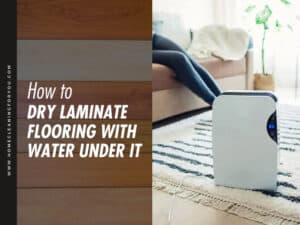
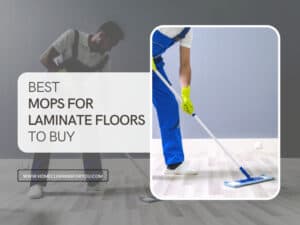
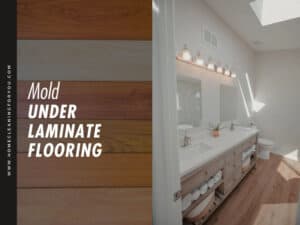
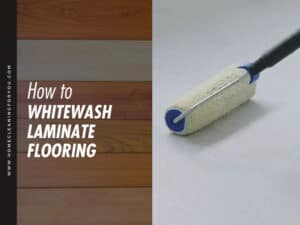
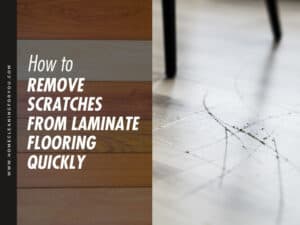
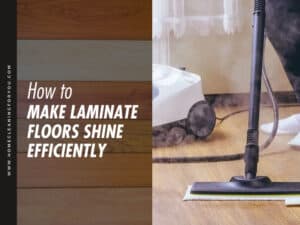
Samantha Lee
Head Cleaning Expert
Expertise
Professional Home Cleaning, Green Cleaning Techniques, Stain Removal & Fabric Care, DIY Home Maintenance & Organization, Sustainable Cleaning Products, Home Care for Busy Lifestyles
Education
University of Denver
Samantha Lee is the Head Cleaning Expert at HomeCleaningForYou.com, specializing in eco-friendly home care. She holds a Bachelor of Science in Environmental Science from the University of Denver, focusing on sustainable cleaning solutions.
With expertise in green cleaning, stain removal, and DIY home maintenance, she helps homeowners keep their spaces fresh and chemical-free. Samantha has been featured in lifestyle publications and has partnered with brands promoting natural cleaning products.
She also shares practical tips through her blog, online courses, and workshops. Passionate about sustainability, she enjoys testing new eco-friendly cleaning methods and spending time outdoors.